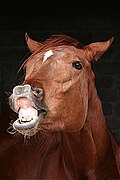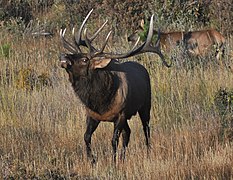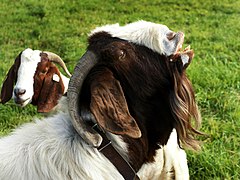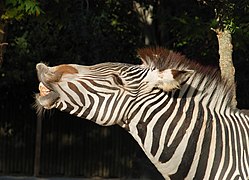The flehmen response (/ˈfleɪmən/; from German flehmen, to bare the upper teeth, and Upper Saxon German flemmen, to look spiteful), also called the flehmen position, flehmen reaction, flehmen grimace, flehming, or flehmening, is a behavior in which an animal curls back its upper lip exposing its front teeth, inhales with the nostrils usually closed, and then often holds this position for several seconds.[1] It may be performed over a sight or substance of particular interest to the animal, or may be performed with the neck stretched and the head held high in the air.
-
Flehmen response in a horse
-
Flehmen response in a Sumatran tiger
-
Flehmen response in a tapir
-
Flehmen response in an elk
-
Flehmen response in a goat
-
Flehmen response in a zebra
Flehmen is performed by a wide range of mammals, including ungulates and felids.[1] The behavior facilitates the transfer of pheromones and other scents into the vomeronasal organ (VNO, or Jacobson's organ) located above the roof of the mouth via a duct which exits just behind the front teeth of the animal.
Etymology
editThe word originates from the German verb flehmen, to bare the upper teeth. It comes from the Upper Saxon German flemmen, "to look spiteful".[2] The word was introduced in 1930 by Karl Max Schneider, director of the Leipzig zoo and an authority on big cats in captivity.[3][4]
Discovery
editThe flehmen response was first described by Frederik Ruysch[when?] and described later by Ludwig Jacobson in 1813.[5]
Description
editThis response is characterized by the animal curling back its top lip exposing the front teeth and gums, then inhaling and holding the posture for several seconds.[3] The behavior may be performed over particular locations, in which case the animal may also lick the site of interest, or may perform the flehmen with the neck stretched and head held high in the air for a more general gustatory or taste-related investigation. The flehmen response often gives the appearance that the animal is looking spiteful, grimacing, smirking, disgusted, or laughing.
Mechanism
editThe flehmen response draws air into the vomeronasal organ (VNO), an auxiliary olfactory sense organ that is found in many animals. This organ plays a role in the perception of certain scents and pheromones. The vomeronasal organ is named for its closeness to the vomer and nasal bones, and is particularly well developed in animals such as cats and horses. The VNO is found encompassed inside a bony or cartilaginous capsule which opens into the base of the nasal cavity.[6] Animals that exhibit flehmen have a papilla located behind the incisors and ducts which connect the oral cavity to the VNO, with horses being an exception. Horses exhibit flehmen but do not have an incisive duct communication between the nasal and oral cavity because they do not breathe through their mouths; instead, the VNOs connect to the nasal passages by the nasopalatine duct.[7]
Chemical cues
editThe chemical cue obtained by an animal exhibiting the flehmen response is the presence of a non-volatile organic compound. In contrast to volatile organic compounds (VOCs), non-volatile organic compounds are those carbon compounds that do not participate in atmospheric photochemical reactions or evaporate under normal atmospheric conditions.[8] The VNO detects non-VOCs, which must have direct contact with the odor source. Sources of non-VOCs relevant to the flehmen response include pheromones and hormones excreted from the genital regions or urine of animals.
Function
editAn animal may perform the flehmen response when investigating sites of particular interest, or perhaps (more generally) odors or tastes. In horses, spontaneous flehmen response outside of the normal context can also indicate discomfort.[9]
Intra-species communication
editThe primary function of the flehmen response is intra-species communication. By transferring air containing pheromones and other scents to the vomeronasal organ (VNO), an olfactory-chemosensory organ located between the roof of the mouth and the palate, animals can gather chemical "messages".[10] These scents tell an animal about other members of their species in some of the following ways:
- Identifying reproductive status – male individuals commonly use the flehmen response as an olfactory mechanism for identifying the reproductive state of females of the same species based on pheromones in the female's urine or genitals.[11] This is exhibited in the reproductive behavior of sheep. The ram often exhibits flehmen after sniffing the ewes' external genital region, but this occurs most frequently on the day before estrus when the ewes are sexually receptive.[12]
- Reproductive synchrony – flehmen behavior also plays a role in reproductive synchrony between females. In the sable antelope, the frequency of flehmen changes seasonally, with the highest levels just prior to conception. Female antelopes associate closely with other females in the same reproductive state. Flehmen rates between females anticipated birth synchrony. Additionally, the level of synchrony was predicted by the frequency of female urine sampling during the previous year. Flehmen is a mechanism used by female sable antelopes to manipulate the timing of both conception and birth of offspring.[13] In the American bison, flehmen behavior in females has also been shown to stimulate the onset of estrus and copulation synchronization.[14]
- Post-parturition – in horses, mares commonly show a peak in flehmen response during the first few hours after giving birth. Smelling the newborn foal and the amniotic fluids associated with birth often produces the reaction.[15]
- Immature animals – in young horses, both colts (males) and fillies (females) exhibit flehmen behavior toward other conspecifics with neither sex performing the behavior more than the other.[1] However, it has been reported that young colts flehmen up to five times more frequently than fillies, and fillies flehmen more frequently than mature mares.[15][contradictory] Young elephants also have a flehmen response to stimulants. The VNO of newborn elephants displays a structural maturity similar to adults, which supports the conclusion that flehmen at only six weeks of age is used to deliver chemical pheromones to a functional VNO.[16]
Inter-species communication
editThe flehmen response is not limited to intra-species communication. Goats have been tested for their flehmen response to urine from 20 different species, including several non-mammalian species. This study suggests there is a common element in the urine of all animals, an interspecific pheromone, which elicits flehmen behavior. Specifically, chemical pheromone levels of a modified form of androgen, a sex hormone, were associated with the response in goats.[17]
Mammals exhibiting
editA wide range of mammals exhibit flehmen including both predatory and non-predatory species.
The response is perhaps most easily observed in domestic cats and horses; both exhibit a strong flehmen response to odors.[18] Stallions usually smell the urine of mares in estrus whereas the male giraffe's flehmen response includes tasting the female's urine.[19] Elephants perform a flehmen response but also transfer chemosensory stimuli to the vomeronasal opening in the roof of their mouths using the prehensile structure, sometimes called a "finger", at the tips of their trunks.[citation needed]
Other animals which exhibit the flehmen response include American bison,[20] tigers,[21] tapirs,[22] lions,[23] giraffes,[19] goats,[24] llamas,[25] kobs,[26] hedgehogs,[27] rhinoceros,[28][29] giant pandas,[30] antelope[10] and hippopotamuses.[31]
References
edit- ^ a b c Weeks, J. W.; Cromwell-Davis, S. L.; Heusner, G. "Preliminary study of the development of the Flehmen response in Equus caballus. 2002. Applied Animal Behavior Science 78(2): 329–35.
- ^ "flehmen". Dictionary.com. Retrieved May 28, 2013.
- ^ a b Hart, Benjamin L (1983). "Flehmen Behavior and Vomeronasal Organ Function". In Müller-Schwarze, Dietland; Silverstein, Robert M. (eds.). Chemical Signals in Vertebrates 3. Springer. p. 87. doi:10.1007/978-1-4757-9652-0_5. ISBN 978-1-4757-9654-4.
- ^ Crowell-Davis, Sharon; Houpt, Katherine A (1985). "The ontogeny of flehmen in horses". Animal Behaviour. 33 (3): 739. doi:10.1016/S0003-3472(85)80005-1. S2CID 53160386.
- ^ Jacobson, L. (1813). "Anatomisk Beskrivelse over et nyt Organ i Huusdyrenes Næse". Veterinær=Selskapets Skrifter [in Danish] 2,209–246.
- ^ "The Vomeronasal Organ". fsu.edu. Archived from the original on 2013-02-11.
- ^ Briggs, Karen (December 11, 2013). "Equine Sense of Smell". The Horse. Retrieved December 15, 2013.
- ^ Volatile Organic Compounds (VOCs): Technical Overview. United States Environmental Protection Agency. http://www.epa.gov/iaq/voc2.html#2. Updated April 10, 2012. Accessed May 9, 2012.
- ^ Torcivia, Catherine; McDonnell, Sue (2021). "Equine Discomfort Ethogram". Animals. 11 (2): 580. doi:10.3390/ani11020580. ISSN 2076-2615. PMC 7931104. PMID 33672338.
- ^ a b Hart, Benjamin L.; Hart, Lynette A.; Maina, J. N. (1988-01-01). "Alteration in vomeronasal system anatomy in alcelaphine antelopes: Correlation with alteration in chemosensory investigation". Physiology & Behavior. 42 (2): 155–162. doi:10.1016/0031-9384(88)90291-0. ISSN 0031-9384. PMID 3368534. S2CID 26589910.
- ^ Doty, Richard (2012-12-02). Mammalian Olfaction, Reproductive Processes, and Behavior. Elsevier. ISBN 978-0-323-15450-5.
- ^ Bland, K. P.; Jubilan, B. M. "Correlation of flehmen by male sheep with female behavior and oestrus". 1987. Animal Behavior 35(3): 735–8
- ^ Thompson, K. V. "Flehmen and birth synchrony among female sable antelope, Hippotragus-niger". 1995. Animal Behavior 50: 475–84.
- ^ Wolff, J. O. "Breeding strategies, mate choice, and reproductive success in American bison". 1998. Oikos 83(3): 529–44.
- ^ a b "Flehmen: 'What's My Horse Doing with His Lip?'" (PDF). Kentucky Equine Research, Inc. Archived from the original (PDF) on October 16, 2012. Retrieved May 29, 2013.
- ^ Johnson, Edward W.; Rasmussen, Lel (2002). "Morphological characteristics of the vomeronasal organ of the newborn Asian elephant (Elephas maximus)". The Anatomical Record. 267 (3): 252–259. doi:10.1002/ar.10112. PMID 12115276. S2CID 30345793.
- ^ Sasada, H.; Kanomata, K.; Fukuoka, T. "Flehmen induction with goats by the urine of twenty animal species". 1988. 11th International Congress on Animal Reproduction and Artificial Insemination, University College Dublin, Irelend, June 26–30, 1988. Volume 4. Brief Communications.
- ^ "Flehmening in cats". Catsguru.com. April 9, 2011. Retrieved May 23, 2012.
- ^ a b "Introduction to the social system of giraffe (Giraffa camelopardalis)". August 17, 2011. Archived from the original on August 17, 2011. Retrieved January 17, 2013.
- ^ "Plains Bison Flehmen". Alaskan Alpine Treks.com. Retrieved June 4, 2008.
- ^ "Enrichment - SCENT". Minnesota Zoo. Archived from the original on January 12, 2008. Retrieved June 4, 2008.
- ^ "Here's "flehmen" at you!". The Tapir Preservation Fund. Archived from the original on October 6, 2008. Retrieved June 4, 2008.
- ^ "Lion Flehmen Display". YouTube. 15 February 2011. Retrieved November 29, 2011.
- ^ "Caring for pygmy goats". Henry and Joey: Pet Pygmy Goats. Retrieved April 12, 2011.
- ^ "Llama body language". The Llama Question and Answer Page. Archived from the original on June 7, 2008. Retrieved June 4, 2008.
- ^ "Sudan White-Eared Kob Animal Profile". Great Migrations - National Geographic Channel. Archived from the original on October 31, 2010. Retrieved November 15, 2010.
- ^ "Anointing and the flehmen response". Peerless Pinto Hedgehogs. Archived from the original on December 19, 2014. Retrieved June 19, 2014.
- ^ "Indian rhinoceros (Rhinoceros unicornis)". Wildscreen Arkive. Archived from the original on 2014-03-05. Retrieved June 19, 2014.
- ^ "Black rhinoceros (Diceros bicornis)". Wildscreen Arkive. Archived from the original on 2014-03-03. Retrieved June 19, 2014.
- ^ Swaisgood, R. R.; Lindburg, D. G.; White, A. M.; Hemin, Z.; Xiaoping, Z. "Chemical Communication in Giant Pandas" (PDF). Retrieved June 4, 2013.
- ^ Zapico, Thomas A. (1999). "First documentation of flehmen in a common hippopotamus(Hippopotamus amphibius)". Zoo Biology. 18 (5): 415–420. doi:10.1002/(SICI)1098-2361(1999)18:5<415::AID-ZOO6>3.0.CO;2-Z.
Further reading
editExternal links
edit- Media related to Flehmen response at Wikimedia Commons





